"Van Gogh" AlgaeIn the style of Van Gogh's "Starry Night," massive congregations of greenish phytoplankton swirl in dark water around Sweden's Gotland (see map) island in a satellite picture released this week by the U.S. Geological Survey (USGS).
The image of the Baltic Sea island is 1 of 40 in the new Earth as Art 3 collection, the latest compilation of Landsat pictures chosen for their artistic quality.
"The collected images are authentic and original in the truest sense," Matt Larsen, the USGS's associate director for Climate and Land Use Change, said in a statement. "These magnificently engaging portraits of Earth encourage us all to learn more about our complex world."
Population explosions, or blooms, of phytoplankton, like the one shown here, occur when deep currents bring nutrients up to sunlit surface waters, fueling the growth and reproduction of these tiny plants, according to the USGS.
(Related: "
The Best Pictures of Earth: Reader Picks of NASA Shots.")
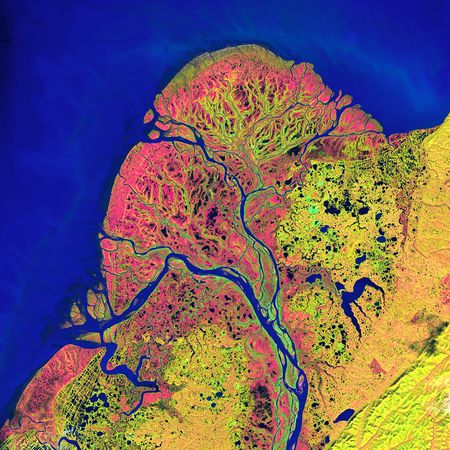
© EROS/USGS/NASA
Like branching blood vessels, the Yukon Delta's sinuous waterways empty into the Bering Sea in a 2002 satellite picture.
The Earth-observing Landsat satellites - jointly managed by NASA and the USGS - sense light in bands of red, green, blue, and infrared. According to the USGS, when the colors are combined into a single image, "fascinating patterns, colors, and shapes emerge" - as in this Yukon Delta picture.
The Yukon River - which begins in the Canadian province of British Columbia and crosses through the Yukon Territory and Alaska - was protected in 2010 as part of the United States' new Yukon Delta National Wildlife Refuge.
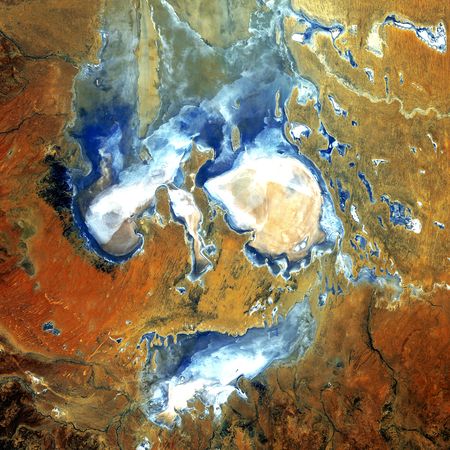
© EROS/USGS/NASA
Patches of southern Australia's shallow Lake Eyre seem to form a grimacing face in an August 2006 satellite picture.
When seasonal rains are plentiful, the water body is Australia's largest lake, according to the USGS. But it's also an "ephemeral" feature in a dry land: The lake has only filled three times during the past 150 years, the USGS noted.
(Read
"Australia's Dry Run" in National Geographic magazine.)
In one of the new Earth as Art 3 satellite pictures, a complex "circuitry" of Greenland fjords among red-tinted mountains ease the flow of glacial ice into the Atlantic Ocean in 2001. (See a Greenland map).
When temperatures rise in the summer, newly calved icebergs here join slabs of sea ice and older, weathered icebergs in an offshore slurry that sometimes "swirls into stunning shapes" (above, right) - according to the USGS.
(Related: "Ice Island Breaks off Greenland; Bigger Than Manhattan.")
Agency scientists selected the Earth as Art 3 pictures - which include cloud formations, coastlines, mountains, islands, deltas, glaciers, and rivers - solely for their aesthetic appeal.
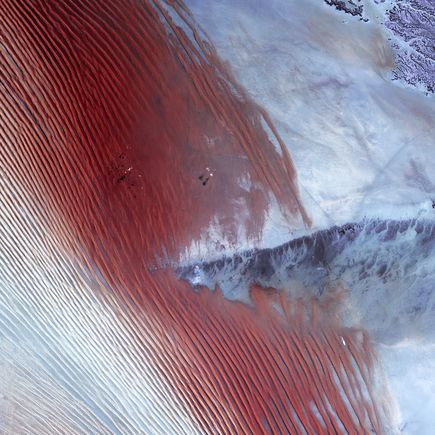
© EROS/USGS/NASA
White bits of cloud cast black shadows on the Rub' al Khali desert (
see map) near the border between Saudi Arabia and Yemen in a 2003 satellite picture.
Earth's largest "sand sea," Rub' Al Khali is striped with lines of wind-sculpted sand, which, in the above picture, are interrupted by a highland ridge. (
See related aerial pictures of mysterious patterns in nature.)
The Earth as Art 3 collection follows the
Earth as Art 1 and
Earth as Art 2 exhibitions, which have been shown in Washington, D.C.'s
Library of Congress and in museums and art centers throughout the U.S.
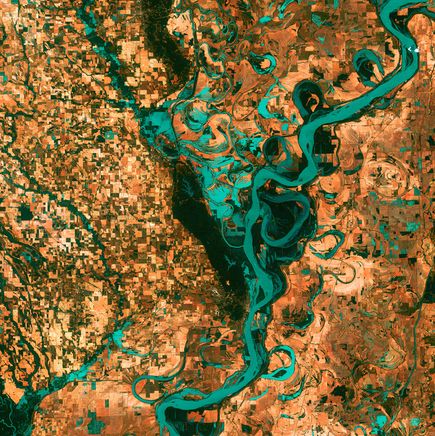
© EROS/USGS/NASA
The Mississippi River - North America's largest - unfurls like a teal ribbon through towns, fields, and pastures on the Arkansas-Mississippi border in a 2003 satellite picture. (
Take a Mississippi River quiz.)
Overall, the Earth as Art collections provide "fresh and inspiring glimpses of different parts of our planet's complex surface," according to the USGS.
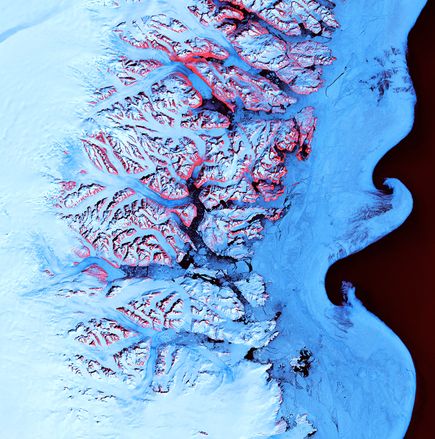
© EROS/USGS/NASA
In one of the new Earth as Art 3 satellite pictures, a complex "circuitry" of Greenland fjords among red-tinted mountains ease the flow of glacial ice into the Atlantic Ocean in 2001. (
See a Greenland map).
When temperatures rise in the summer, newly calved icebergs here join slabs of sea ice and older, weathered icebergs in an offshore slurry that sometimes "swirls into stunning shapes" (above, right) - according to the USGS.
(Related:
"Ice Island Breaks off Greenland; Bigger Than Manhattan.")
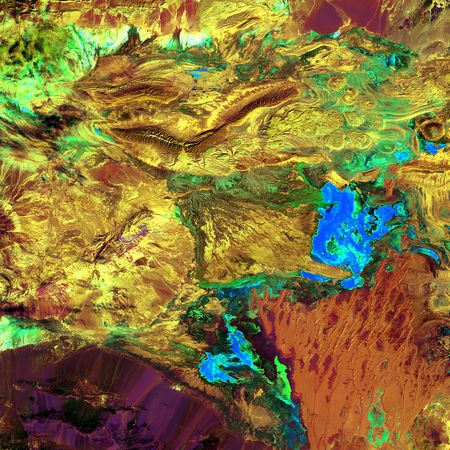
© EROS/USGS/NASA
Like poster paints run wild, a 2003 image captures an "eclectic montage" of landscapes in Iran's largest desert, the Dasht-e Kavir, or Great Salt Desert, according to the USGS.
The mostly uninhabited region - a mix of dry streambeds, desert plateaus, mud flats, and salt marshes - covers an area of more than 29,730 square miles (77,000 square kilometers). (
See more pictures of desert landscapes.)
"Extreme heat, dramatic daily temperature swings, and violent storms are the norm in this inhospitable place," the USGS said.
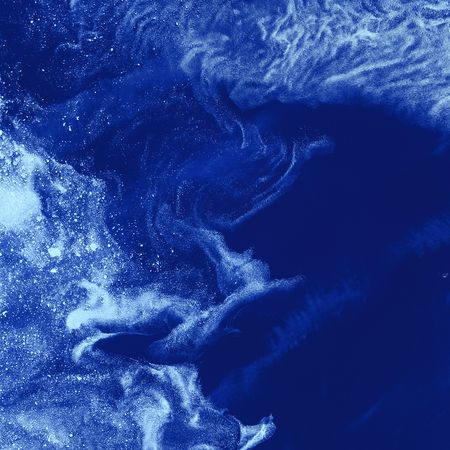
© EROS/USGS/NASA
Resembling distant galaxies amid clouds of interstellar dust, chunks of sea ice drift through swirls of grease ice near Canada's Baffin Island (
see map) in 2002.
Sea ice often begins as grease ice, a soupy slick of tiny ice crystals on the ocean's surface, according to the USGS. As the temperature drops, grease ice thickens and coalesces into solid ice slabs.
(
See pictures of how global warming is changing the Arctic.)
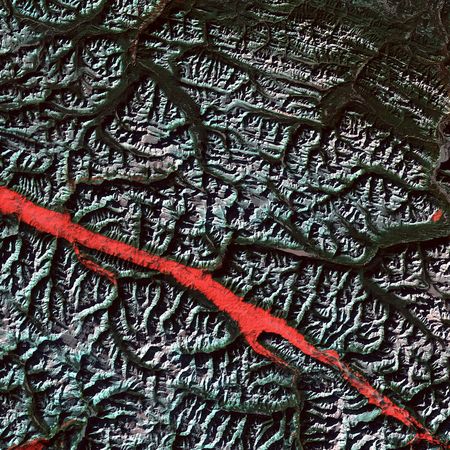
© EROS/USGS/NASA
What looks like red paint is actually a "remarkable interplay of light and cloud" captured in 2004 in the Canadian Rockies, according to the USGS.
Low clouds filled a part of the Rocky Mountain Trench, which sits near the border between the Canadian provinces of Alberta and British Columbia. Light reflecting off the clouds, coupled with low sun elevation, "resulted in this startling effect," the USGS noted.
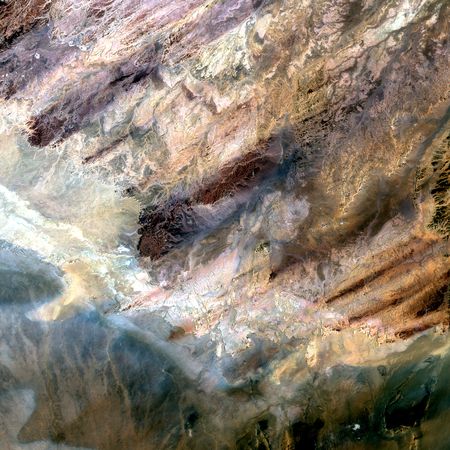
© EROS/USGS/NASA
Tin Bider, an ancient and eroded meteor crater in the Algerian Sahara, glimmers in a 2009 picture. Nearly 3.7 miles (6 kilometers) wide, the crater was caused by a meteorite impact in this region of northern Africa roughly 70 million years ago.
Reader Comments
to our Newsletter